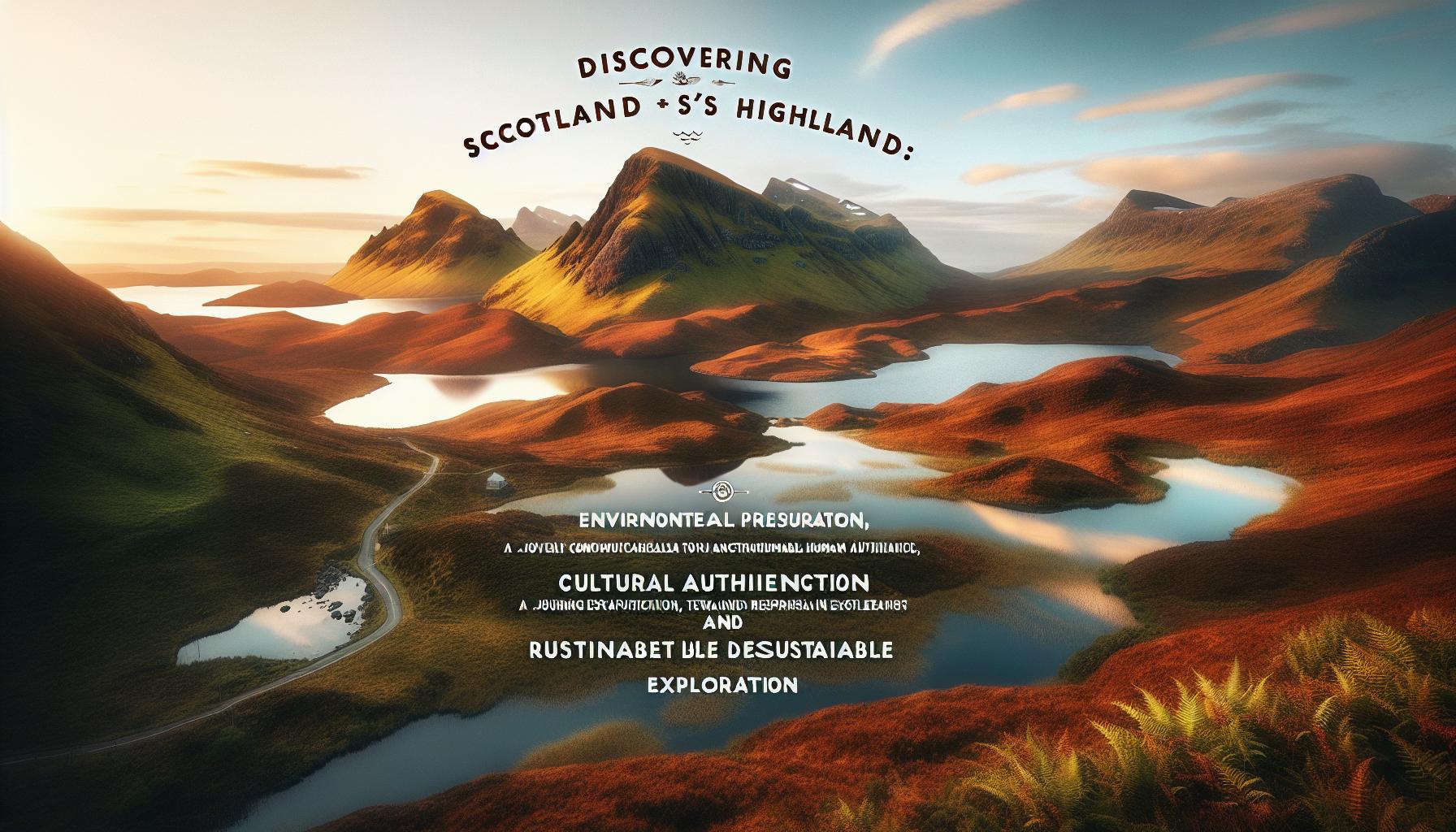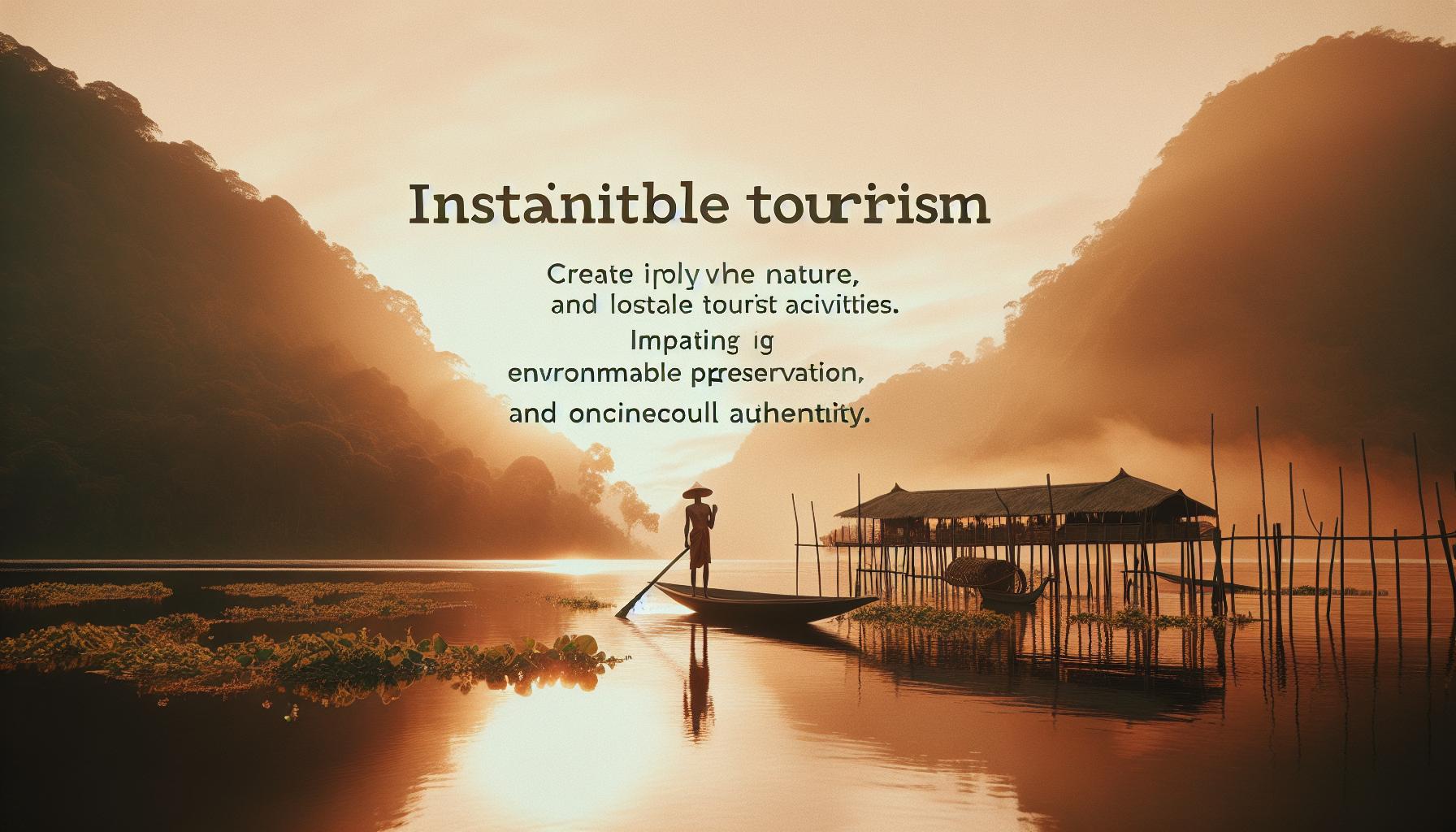As scotland’s breathtaking landscapes draw more visitors each year, teh challenge of balancing tourism with environmental stewardship becomes increasingly vital. How can we explore the stunning Highlands and rich cultural heritage without compromising the natural beauty we cherish? Embracing sustainable practices is essential for preserving Scotland’s treasures for future generations while enhancing the travel experience.
Discovering Scotland’s Highlands: A Journey Towards Sustainable Exploration
Embracing Nature with Responsible travel
Scotland’s Highlands offer a breathtaking tapestry of rugged mountains, shimmering lochs, and windswept grasslands that has captivated the hearts of travelers for centuries.As more adventurers seek to explore these stunning landscapes, the emphasis on sustainable tourism has never been more critical. Visitors to this enchanting region are not only drawn to its natural beauty but are also becoming increasingly aware of their impact on the environment. The journey toward a responsible exploration of the Highlands involves understanding how to engage with the local ecosystem while appreciating the rich heritage that defines this iconic Scottish landscape.
To truly appreciate the intricacies of the Highlands, travelers can adopt several sustainable practices:
- Choose Eco-Friendly Accommodations: Opt for lodgings that prioritize sustainability, such as those utilizing renewable energy or implementing water-saving initiatives.
- Reduce Plastic Use: Bring reusable bottles, bags, and utensils to minimize waste during your travels in the pristine Highlands.
- Support Local Businesses: Dine at local restaurants and shop at community-owned stores to bolster the economy and foster regional culture.
- Tread Lightly: Stick to marked trails while hiking to protect delicate ecosystems, and avoid disturbing wildlife.
Engagement with Heritage and Community
Scotland’s sustainable travel philosophy extends beyond environmental considerations; it deeply honors the region’s rich cultural legacy. Engaging with local communities not only enriches the visitor experience but also helps preserve the heritage that makes the Highlands unique. Activities such as community-led tours and workshops allow travelers to immerse themselves in local traditions, from craft workshops to culinary experiences that highlight traditional Scottish cooking methods.A key part of this journey is understanding the history that intertwines with the landscapes.Highland castles, ancient stone circles, and ancient battlefields tell tales of the past, while local museums frequently enough feature exhibitions focusing on the region’s heritage. Here are a few examples of sites worth visiting:
| Site | Description | Highlights |
|---|---|---|
| Urquhart Castle | A stunning fortress on the shores of loch Ness. | Scenic views, rich history, and local legends. |
| Culloden Battlefield | The site of the last battle fought on British soil. | Interactive exhibits and guided tours. |
| The Isle of Skye | Famed for its rugged landscape and vibrant culture. | Local artisan markets and traditional music sessions. |
By cherishing the cultural fabric of the Highlands and making conscious choices while exploring, visitors contribute to the preservation of the area’s heritage and environment. When combined with the adventure of visiting Scotland’s breathtaking landscapes, this commitment to sustainability transforms the journey into one of profound respect and appreciation.
Embracing Heritage: The Role of Local Culture in Sustainable Tourism
By 2030, travel and tourism could be responsible for creating millions of jobs, closely tied to the preservation of cultural heritage and local traditions. In Scotland, this connection is particularly vivid, showcasing how local culture can drive sustainable tourism while preserving the charm of the Highlands.
The Importance of Local Culture
Local culture serves as both the heart and soul of tourism in the Highlands. Visitors are not merely looking for scenic landscapes; they want authentic experiences that allow them to connect with the history and traditions of the place. This is where embracing heritage becomes crucial for sustainable tourism. by advocating for cultural awareness and preservation, Scotland can continue to attract travelers while safeguarding its rich heritage.
Integrating Heritage in Tourism Practices
Destination management organizations are beginning to champion sustainable tourism practices that emphasize local culture. experiences such as:
- Guided tours of historic sites: These provide insights into the local heritage, frequently enough led by locals who share stories and traditions.
- Cultural festivals: By hosting events that celebrate local traditions, communities can engage tourists while promoting their cultural heritage.
- workshops and arts: Activities like traditional crafts or cooking classes allow visitors to engage hands-on with local culture, fostering a deeper appreciation.
each of these practices not only enriches the visitor experience but also supports local artisans and businesses, encouraging economic sustainability.
Responsible Engagement and Community Involvement
For sustainable tourism to flourish, it’s essential that local communities play an active role. Engaging them in tourism planning and decision-making ensures that initiatives reflect their values and priorities. This collaborative approach can lead to:
- Enhanced visitor experiences: Tourists enjoy more authentic interactions and stories.
- Greater economic benefits: More profits remain within the community, supporting local businesses.
- Better cultural preservation: Locals are motivated to maintain traditions when they see direct benefits.
| Practices | Benefits |
|---|---|
| Guided historical tours | Increased visitor knowledge and appreciation |
| Cultural festivals | Community engagement and tourism boost |
| Local craft workshops | Support for local artisans and craftspeople |
Scotland’s journey towards sustainable tourism is deeply intertwined with its cultural heritage. Through intentional community involvement and the promotion of authentic experiences, the Highlands can thrive as both a tourist destination and a bastion of rich cultural tradition. By embracing heritage, local culture doesn’t just survive; it flourishes, ensuring that Scotland remains a unique and precious destination for generations to come.
Eco-friendly Accommodations: Finding Green Stays in the Scottish Highlands
Visiting the Scottish Highlands doesn’t mean compromising your values of sustainability and environmental stewardship. Actually, the region is home to a growing number of eco-friendly accommodations that embrace the principles of sustainable tourism, allowing travelers to revel in nature without leaving a heavy footprint. Whether you’re seeking a cozy cottage or a luxurious lodge, understanding how to find these green stays can substantially enhance your travel experience while supporting local communities and conservation efforts.
What to Look For in Eco-friendly Accommodations
When selecting a place to stay in the Highlands that aligns with your commitment to sustainability,consider the following factors:
- Green Certification: Look for accommodations certified by organizations like Green Key or Visit Scotland’s Green Tourism scheme,which assess environmental practices.
- Renewable Energy: Choose places powered by renewable sources such as solar panels or wind energy, reducing reliance on fossil fuels.
- Local Sourcing: Opt for accommodations that use locally sourced materials for construction and decor, and also restaurants that serve locally-produced food.
- Waste Management: Assess whether the property has a robust recycling and composting program in place to minimize waste.
- Community Engagement: Supporting lodges that engage with the local community ensures that your stay contributes directly to the conservation and sustainability of the Highland region.
Top Eco-friendly Stays in the Scottish Highlands
Here’s a selection of remarkable eco-friendly accommodations that showcase the Highlands’ commitment to sustainable tourism:
| Accommodation Name | Location | Key Features |
|---|---|---|
| The White House | Fort William | Powered by wind energy,offers locally-sourced meals and eco-friendly toiletries. |
| Glenshee glamping | Aberdeenshire | Unique eco pods surrounded by nature, featuring compost toilets and zero-waste principles. |
| Corriemollice | Strathspey | Traditional lodge,utilizing renewable energy and employing local artisans for decor. |
| Fasgadh Eco Retreat | Near Aviemore | Green certification,organic gardening,and waste reduction initiatives. |
by opting for sustainable accommodations in the Scottish Highlands, travelers not only enjoy extraordinary landscapes and rich cultural experiences but also foster a travel philosophy that respects and preserves this stunning environment. Embrace eco-friendly living while exploring the enchanting beauty of the Highlands, and contribute positively to the local ecosystem and community. With the commitment to sustainability woven into the fabric of your stay, every moment spent in this breathtaking region will resonate with purpose and respect for its heritage and natural wonders.
Engaging with Nature: Responsible Outdoor Activities in Scotland
Immerse Yourself in Scotland’s Breathtaking Nature
Scotland is renowned for its dramatic landscapes, ranging from the rolling hills of the Highlands to the pristine shores of its islands. Engaging with nature here is not just about exploration; it’s about fostering sustainability while cherishing the breathtaking beauty around you.By participating in responsible outdoor activities, visitors can enjoy scotland’s natural wonders while ensuring that these treasures are preserved for future generations.
Hiking and Walking
One of the most popular ways to appreciate the scenic vistas is through hiking. The Scottish National Trails offer well-marked paths that wind through the most stunning parts of the country. Here are a few tips for responsible hiking:
- Stay on designated paths to minimize your impact on the environment.
- Respect wildlife by observing from a distance and not disturbing their habitats.
- Carry out all litter and leave no trace behind.
Consider participating in organized hiking tours that emphasize sustainability. These not only provide a structured experience but also often include educational components about local ecosystems and conservation efforts.
Water Activities and Conservation
Scotland’s lochs and rivers offer a plethora of opportunities for water-based activities. Kayaking and canoeing are exemplary ways to explore while maintaining a low impact on nature. Many organizations operate eco-friendly tours that promote conservation awareness.
Actionable Tips for Water Activities:
- Choose eco-friendly gear made from sustainable materials.
- Follow water safety regulations and local guidelines to protect aquatic ecosystems.
- Join a clean-up day or participate in local conservation projects to help maintain the waterways.
By consciously engaging in these activities, you contribute to the vitality of Scotland’s waterways, ensuring they remain clean and accessible for all.
Wildlife Watching: A Sustainable Approach
Scotland’s unique biodiversity offers countless opportunities for wildlife watching,from the red deer in the Highlands to seabirds along the coastlines. To ensure that your experience benefits the environment, consider the following:
| Wildlife Watching tips | Benefits |
|---|---|
| use a guide who is informed about local wildlife | Enhances your experience and minimizes disturbance |
| Keep a safe distance and use binoculars | Protects animals from stress |
| Participate in citizen science projects | Contributes to conservation efforts and research |
By adhering to these principles, your wildlife encounters can support local conservation initiatives while promoting the awareness and appreciation of Scotland’s natural heritage.Scotland is committed to sustainable tourism,particularly emphasizing the importance of responsible outdoor activities that engage with its unusual landscapes and rich heritage. By following these guidelines, you can enjoy the wilderness while helping to preserve it, embodying the essence of Scotland Sustainable Tourism: Highlands, Heritage, and Sustainability Combined.
Community-driven Initiatives: how Locals Are Shaping Sustainable Travel
In Scotland’s breathtaking Highlands,locals are not just passive witnesses to the beauty of their environment—they are active participants in shaping the future of sustainable tourism. This hands-on approach ensures that the benefits of tourism are felt within the community and that the rich heritage of the region is preserved for generations to come. By fostering a connection between visitors and residents, these community-driven initiatives create a more authentic travel experience while minimizing the ecological footprint of tourism.
Empowering Communities through Local Projects
Community-led initiatives often focus on sustainable practices that reflect the unique culture and environment of the Highlands.For exmaple, initiatives like the Highland Clearances Heritage Trail allow visitors to explore meaningful historical sites while supporting local artisans and heritage projects. This type of engagement not only educates travelers about Scotland’s complex history but also drives revenue back into local economies.
- Conservation Volunteering: Programs that recruit tourists to participate in conservation work help preserve the natural landscapes tourists come to enjoy. Activities can include restoring local habitats, managing wildlife, and maintaining trails.
- Cultural Festivals: Events that celebrate local music, food, and craftsmanship invite tourists to immerse themselves in Highland culture, allowing locals to showcase their traditions while stimulating the economy.
- Community Tourism Networks: Collaborations among local businesses, such as bed and breakfasts, guided tours, and restaurants, create comprehensive packages that highlight the best of sustainable tourism while ensuring that profits circulate within the community.
Real-World Examples: A Model for Others
One inspiring model is the Skye Cooperative, which has focused on sustainable tourism practices that benefit both the island and its inhabitants. Their efforts include developing eco-friendly accommodations and promoting local produce, enabling visitors to experience authentic Highland culture without contributing to environmental degradation. Initiatives like these are paving the way for an eco-conscious tourism sector that values heritage and community well-being.
| Initiative | Description | Impact |
|---|---|---|
| Highland Clearances Heritage Trail | A trail highlighting historical sites related to the Highland Clearances | Promotes cultural tourism and supports local artisans |
| Skye Cooperative | Community-based tourism focusing on sustainability and local goods | Enhances local economy and preserves cultural heritage |
| Conservation Volunteering | Tourist participation in environmental conservation projects | Protects natural resources and fosters environmental awareness |
Through these innovative community-driven initiatives, the Highlands of Scotland are not only preserving their heritage but also redefining what it means to be a tourist in today’s world. This collaborative spirit among locals and visitors alike ensures a sustainable future where everyone has a stake in the success of Scotland sustainable tourism: Highlands, heritage, and sustainability combined.
Culinary Sustainability: Savoring Scotland’s Local Flavors Responsibly
The Scottish Highlands are not just a feast for the eyes; they’re a cornucopia of local flavors that tell the story of the region’s rich heritage and commitment to sustainability. Scotland boasts an array of unique ingredients—from fresh seafood harvested along its rugged coastlines to lush grains and seasonal vegetables grown in its fertile valleys. By prioritizing culinary sustainability, both chefs and diners can contribute to a thriving ecosystem while enjoying the mouthwatering essence of Scotland.
Supporting Local Producers
one of the most impactful ways to savor Scotland’s local flavors responsibly is by engaging directly with local producers. Farmers, fishermen, and artisan food makers frequently enough sell their goods at farmers’ markets, allowing consumers to purchase seasonal offerings and understand the origins of their meals. This practice not only supports the local economy but also reduces the carbon footprint associated with transporting food.Options for engaging with local producers include:
- Visiting farmers’ markets in cities like Edinburgh and Glasgow.
- Participating in farm-to-table dining experiences.
- Taking guided tours to local distilleries or breweries.
By fostering relationships with these producers,diners can make informed choices that reflect a commitment to sustainability.
Embracing Seasonal and Foraged Ingredients
Scotland’s ever-changing seasons create a diverse landscape of flavors waiting to be explored. Chefs across the region are embracing this by crafting menus that highlight seasonal ingredients. This not only celebrates Scotland’s unique palette but also aligns with the principles of sustainable cooking—using what is at hand ensures minimal waste and supports the local farming community.
For example, chefs may rely on ingredients like:
| Season | Ingredients |
|---|---|
| Spring | Asparagus, Wild Garlic, Rhubarb |
| Summer | Berries, New Potatoes, Fresh Fish |
| Autumn | Game, Mushrooms, apples |
| Winter | Cabbage, Kale, Root Vegetables |
foragers are increasingly sought after in the culinary scene, gathering wild ingredients like seaweed and herbs that enrich dishes and enhance their sustainability. Diners can actively support these initiatives by choosing restaurants that prioritize local, seasonal menus.
Responsible Seafood Practices
Scotland’s extensive coastline is home to some of the finest seafood in the world, but sustainability must remain at the forefront of fishing practices. By choosing to dine at establishments that promote sustainable seafood sourcing—such as those certified by the Marine Stewardship Council (MSC)—diners play a critical role in preserving marine ecosystems while indulging in local delicacies.
Additionally, eco-conscious restaurants frequently enough display their sourcing practices, empowering patrons to make dinner decisions that echo their values. By supporting these establishments, you help ensure that future generations can enjoy Scotland’s rich bounty from the sea.
Scotland’s commitment to sustainable culinary practices is not just about eating; it’s about making mindful choices that respect the land, sea, and communities that craft these flavors. Culinary sustainability is the gateway to exploring the Highlands’ vibrant culinary scene while playing an active role in preserving its natural heritage.
The Impact of Tourism on Conservation: Balancing Exploration with Preservation
Did you know that tourism is one of the largest global industries, accounting for approximately 10% of the world’s GDP? This massive sector has the potential to either threaten or bolster conservation efforts, particularly in pristine environments like the Scottish Highlands. As visitors flock to these iconic landscapes, the challenge lies in how to leverage the economic benefits of tourism while safeguarding the natural and cultural heritage that makes Scotland so unique.
The Dual Role of Tourism in Conservation
Tourism can be a double-edged sword, providing vital funding for local conservation projects while simultaneously posing risks to the very ecosystems that attract visitors. In Scotland, a growing emphasis on sustainable tourism is paving the way for a balance between exploration and preservation. Here are some key impacts of tourism on conservation efforts:
- Financial Support: Entrance fees to national parks and heritage sites frequently enough funnel directly into conservation initiatives, helping to maintain trails, protect endangered species, and restore habitats.
- Awareness and Education: Tourists often leave with a deeper understanding of the environment and the challenges it faces, fostering a community of informed advocates who may support conservation efforts long after their visit.
- Pressure on Resources: An influx of visitors can strain local infrastructure and natural resources, leading to challenges such as pollution, habitat degradation, and wildlife disturbances.
Best Practices for Sustainable Tourism in Scotland
To harness the benefits of tourism while minimizing negative impacts, several best practices are being implemented throughout Scotland. These include:
| best Practice | Description |
|---|---|
| Visitor Management Plans | Strategically limiting numbers at sensitive sites to reduce wear and tear on natural resources. |
| Eco-Tourism Initiatives | Encouraging activities like wildlife watching and hiking that emphasize low-impact enjoyment of the environment. |
| Community Involvement | Involving local communities in tourism operations to ensure that they benefit directly from visitors and their spending. |
One shining example of this balance is the Knoydart Peninsula, where local tourism operators focus on small-group adventures that limit ecological impact, such as hiking and kayaking, allowing visitors to immerse themselves in the landscape without overwhelming it. This commitment not only attracts eco-conscious travelers but also empowers locals to share their rich heritage,fostering a sense of pride and stewardship for the land. By adopting such practices, the Highlands can serve as a model for sustainable tourism where exploration is harmonized with preservation, ensuring that Scotland’s extraordinary landscapes endure for generations to come.
Planning Your Sustainable Trip: Tips for Eco-conscious Travelers in Scotland
Did you know that Scotland’s breathtaking landscapes and rich cultural heritage make it a prime destination for eco-conscious travelers? As you embark on your sustainable trip to Scotland, consider these practical tips to make your journey both responsible and rewarding.
Choose Eco-Friendly Accommodation
Selecting an eco-friendly place to stay is crucial in reducing your environmental footprint. Look for accommodations that prioritize sustainability through energy-efficient practices, local sourcing of food, and respect for nature. Many lodges and hotels in the Highlands are committed to sustainable tourism. Websites like Green Key and the Sustainable Tourism Accreditation can help you identify properties that meet high environmental standards.
Travel Off-Peak and Use Sustainable Transport
Timing matters when planning your visit. Opting to travel during off-peak seasons not only enhances your experience by avoiding large crowds but also helps reduce the strain on local resources.When in Scotland, consider utilizing public transportation, such as trains and buses, or even renting bicycles to explore the stunning scenery. Carpooling with other travelers can also minimize your carbon footprint while allowing you to share experiences and make new friends.
Engage with Local Communities
Supporting local communities is a cornerstone of sustainable tourism. Participate in community-led tours and workshops that showcase traditional crafts and local gastronomy. This not only provides an authentic experience but also helps sustain local economies. Additionally, buying souvenirs and products from local artisans ensures that your spending benefits those who contribute to the preservation of Scotland’s rich heritage and natural beauty.
Respect Nature and Wildlife
As you explore Scotland’s majestic landscapes,it’s vital to practice responsible nature tourism. Stick to marked paths to minimize your impact on the environment, and avoid disturbing wildlife, particularly during breeding seasons. Always follow the ‘Leave No Trace’ principles, ensuring that you carry out any waste and leave the places you visit as you found them.
| Tip | Description |
|---|---|
| Eco-Friendly Accommodation | Stay in places that prioritize sustainability. |
| Travel Off-Peak | Visit during off-peak times to reduce crowding. |
| Sustainable Transport | Use public transport, bicycles, or carpool. |
| engage Locally | Participate in community-led activities and tours. |
| Respect Nature | Follow designated paths and observe wildlife rules. |
By embracing these sustainable practices, your journey through Scotland will not only be enjoyable but also contribute to the preservation of its stunning landscapes and rich cultural heritage. Remember, sustainable tourism is about making thoughtful choices that benefit both you and the beautiful environments you visit.
Insights and Conclusions
As we conclude our exploration of Scotland’s sustainable tourism, it’s clear that the Highlands offer more than just breathtaking landscapes; they present a unique opportunity to engage with rich heritage while prioritizing environmental stewardship. By choosing local accommodations, supporting community businesses, and embracing nature-friendly practices, travelers can make a meaningful contribution to preserving Scotland’s natural beauty and cultural legacy. We encourage you to delve deeper into this captivating part of the world—consider planning a trip that honors both the land and its people. Whether you’re a curious traveler or an industry professional,your actions have the power to foster a more sustainable future. Let’s continue to champion these initiatives together, discovering ways to enjoy our journeys while protecting the places we cherish for generations to come. Safe travels and happy exploring!







